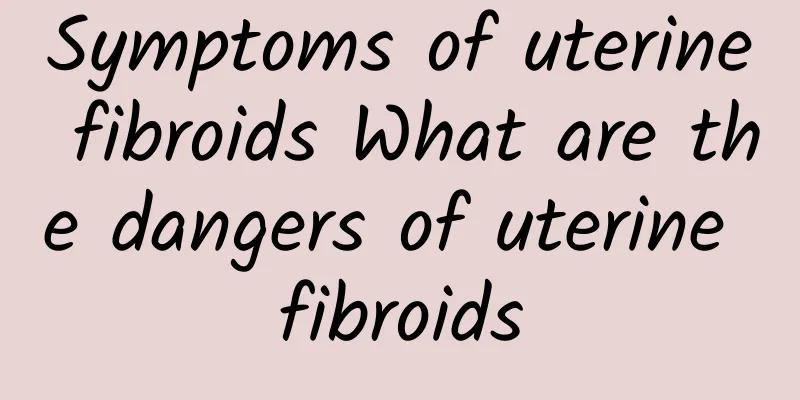Symptoms of uterine fibroids What are the dangers of uterine fibroids

|
Although according to statistics, at least 20% of women of childbearing age suffer from uterine fibroids, since most uterine fibroids have no more or less clinical symptoms, the incidence reported by clinical reports is much lower than the actual incidence of fibroids. So what are the symptoms of uterine fibroids? Most uterine fibroids have no obvious symptoms and are only discovered accidentally during a physical examination. Symptoms are related to the location, size, and degeneration of the fibroids. Common symptoms include: (1) Increased menstrual volume and prolonged menstruation: more common in large intramural fibroids and submucosal fibroids. Fibroids increase the uterine cavity and the area of the endometrium, affecting uterine contraction and hemostasis during menstruation. In addition, fibroids may squeeze the veins near the tumor, causing congestion and dilation of the uterine venous plexus, resulting in increased menstrual volume and prolonged menstruation. The symptoms of submucosal fibroids are more obvious. If submucosal fibroids are accompanied by necrotic infection, there may be irregular vaginal bleeding or bloody purulent discharge. Long-term increased menstrual volume may lead to secondary anemia, fatigue, palpitations and other symptoms. (2) Lower abdominal mass: The mass cannot be felt within 12 hours of the uterus. When the uterus is more than 3 months pregnant, a hard mass can be felt from the abdomen, which is more obvious when lying flat in the morning. Huge submucosal fibroids can prolapse from the cervix or even outside the vagina, and the patient can prolapse the mass from the vulva. (3) Increased vaginal discharge: Intramural fibroids increase the area of the uterine cavity, increase endometrial secretions, and are accompanied by pelvic congestion, leading to increased vaginal discharge; once the submucosal fibroids of the uterus are infected, there will be a large amount of purulent vaginal discharge. If the fibroids are ulcerated, necrotic, or bleeding, there may be bloody or purulent vaginal discharge with a foul odor. (4) Compression symptoms: If the anterior uterine wall fibroids compress the bladder, it can cause frequent urination and urgency; cervical fibroids can cause dysuria and urinary retention; posterior uterine wall fibroids can cause lower abdominal swelling, constipation and other symptoms. Broad ligament fibroids or giant cervical fibroids develop laterally, embed into the pelvic cavity, compress the ureter, and cause ureteral dilatation, hydronephrosis, and even one kidney failure. (5) Other symptoms: Common symptoms include mild lower abdominal swelling and back pain, which may be aggravated by menstruation. It may cause infertility or miscarriage. Acute lower abdominal pain, vomiting, fever and local tumor tenderness; subserosal myoma pedicle torsion may cause acute abdominal pain; submucosal myoma of the uterus may also cause paroxysmal lower abdominal pain. Uterine fibroids are a common gynecological disease, and the common treatments are surgery or medication. Paying attention to daily maintenance and taking appropriate medication can control uterine fibroids. |
>>: What are the common symptoms of uterine fibroids? Can uterine fibroids cause uterine bleeding?
Recommend
Threatened abortion specialist hospital
Everyone is very aware of the seriousness of thre...
Is it possible to be obese and healthy at the same time?
Eating greasy food, sitting for long periods of t...
No NG if you are slim! TOP 10 Wrong Weight Loss Methods
"My belly is so big, my pants are getting ti...
Briefly talk about the common causes of dysmenorrhea
Dysmenorrhea is a disease that is very detrimenta...
What are the symptoms of cystic ovarian cysts and how to treat them
What are the symptoms of cystic ovarian cysts and...
What are the harmful effects of abortion? There are 4 major harms
The abortion rate is very high now, but most peop...
Can I cure endometrial thickening?
If you have endometrial thickening, can it be cur...
Can uterine fibroids heal on their own?
Uterine fibroids cannot heal on their own. Howeve...
Is laparoscopy effective for left ovarian cyst? What should I pay attention to in my diet?
Nowadays, medicine is developed, and many disease...
What are the specific symptoms of vulvar leukoplakia?
Vulvar leukoplakia is a type of gynecological dis...
Do you know what are the precautions for abortion?
What are the precautions for abortion? When perfo...
Experts analyze the causes of irregular menstruation in women
Irregular menstruation is a condition that most w...
Do you know what are the early symptoms of ovarian cysts?
What are the early symptoms of ovarian cysts? Wha...
What are the main symptoms of cervicitis?
The incidence of cervicitis has been increasing i...
Why do we need to do gestational sac test after miscarriage? What is the purpose of gestational sac test after miscarriage?
Many women want to have a healthy baby after they...









